



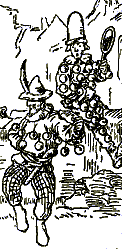 |
Prague, 18th Cent. |
 Purim, Lots (as in the drawing of lots) is a minor festival which falls on the 14th of Adar or in leap years falls on the 14th of Adar Sheni, (2nd Adar). (See JEWISH CALENDAR) In some communities, on a leap year they keep the 14th of Adar Rishon (1st Adar) as a minor Purim, known as Purim Katan. The name of Purim is derived from the book of Esther, 1. when lots were drawn to decide the date when the Jewish community of Persia were to be attacked and plundered.
Purim, Lots (as in the drawing of lots) is a minor festival which falls on the 14th of Adar or in leap years falls on the 14th of Adar Sheni, (2nd Adar). (See JEWISH CALENDAR) In some communities, on a leap year they keep the 14th of Adar Rishon (1st Adar) as a minor Purim, known as Purim Katan. The name of Purim is derived from the book of Esther, 1. when lots were drawn to decide the date when the Jewish community of Persia were to be attacked and plundered.
It is a minor festival because
(1.) Esther 3, 7. and 9, 26. (2.) Esther 9, 19 and 9, 22.
 |
honours Mordecai. Woodcut, Ilya Schor. |
The festival of Purim is based on the events recounted in the Book of Esther. It tells how Esther, a Jewish girl, was brought up by her uncle Mordecai in Shushan in Persia. Following Queen Vashti's refusal to obey her husband, Esther married King Ahasuerus without telling him that she was a Jewess. Meanwhile the xenophobic prime minister called ![]() planned to get rid of all the Jews because Mordecai refused to bow down to him. Mordecai persuaded Esther to intercede with the King on behalf of the Jews, which she did at great risk to herself. The King then permitted the Jews to defend themselves against their persecutors, many of whom they killed. The festival, therefore, celebrates the deliverance from a severe threat of anti-Semitism, and it's observance was instituted by Mordecai. 3.
planned to get rid of all the Jews because Mordecai refused to bow down to him. Mordecai persuaded Esther to intercede with the King on behalf of the Jews, which she did at great risk to herself. The King then permitted the Jews to defend themselves against their persecutors, many of whom they killed. The festival, therefore, celebrates the deliverance from a severe threat of anti-Semitism, and it's observance was instituted by Mordecai. 3.
(3.) Esther 9, 20-2.
Although Persian royal records are fairly complete, we can find no record of a Queen Esther, a Queen Vashti or of the mass killing of the Jews' enemies. The language used in the book is from a later period than the story describes. It is also remarkable coincidence that the names of Mordecai and Esther are very similar to those of Marduk and Ishtar, the twin gods of Babylon. This has led some to suggest that rather than Purim being based on the Book of Esther, that perhaps there had been a forgotten older festival that was Judaised.4. The story of Esther may well have been written to give Jewish meaning to that older festival. (See more on Schauss' view in BLOTTING OUT THE NAME. ) It has been suggested that the book may date from the Hasmonean times 5. where it was linked in the reader's mind with deliverance from Antiochus. One of the earliest records of the festival being observed was in about 100 BCE,6. where it was called Mordecai's Day. It may well be significant that while Mordecai's Day was on the 14th of Adar, the Hasmonean festival of Nicanor's day, which also celebrated deliverance from danger, was on the 13th of Adar.7.
By the time of the Mishnah in c. 210 CE the festival was sufficiently widely observed to warrant the inclusion of a tractate called Megillah. It was still relatively unimportant; but the book of Esther was read in synagogues. By then, Nicanor's day was no longer observed. (See also FAST OF ESTHER.) During the middle ages when persecutions of Jews were frequent, Purim became a day when the Jews hoped that they too might be free from attacks. The custom of BLOTTING OUT the name of ![]() was introduced first in writing and then later in sound.
was introduced first in writing and then later in sound.
(4.) Schauss: Jewish Festivals, p. 250. (5.) Graetz as cited by Schauss, p.248. (6.) 2 Maccabees, 15, 36. (7.) 2 Maccabees 15, 36.

Purim is a very joyful occasion. The emphasis is on joy and laughter following the deliverance from the danger of persecution and death. Often people come to Synagogue in fancy dress and the day is one for light-hearted entertainment.(see the pictures on this web page) There is a carnival atmosphere everywhere. (see DRINKING. ) Sometimes the tunes of the singing parts of the services are deliberately altered to express this mood. Some bakers bake challot with hundreds and thousands on the instead of the normal seeds.
It is interesting to note that the word Carnival comes from Carne vale which means in Italian means farewell to meat. Many Christians stop eating meat during Lent, and in the week before this solemn period they introduced the practice of carnivals. There seems to be a link between the observance of Purim and these celebrations which occur at the same time of year. Probably both are based upon earlier celebrations of the fact that winter was now over. Masquerades first appeared in Italy in the late fifteenth century and are first mentioned by Judah Minz of Venice, and pantomime cross dressing is also mentioned by Isserles.8.
(8.) JE vol. X, p. 277 & S.A. Orach Chayim 696, 8.

The main feature of the festival is the reading of the Book of Esther from a small scroll, known as  (the Megillah). The reading takes place first on the eve and then on the morning of Purim. It is usually read in Hebrew, but can be read in any language which the congregation understands.9. Many congregants bring their own megillot along to follow the reading. In early times there was discussion as to how much was required to be read. Rabbi Judah said from chapter 2 verse 5, Rabbi Jose from chap. 3 verse 1 and Rabbi Meir said all of the book had to be read.10. Talmudic discussion confirmed Rabbi Meir's view.11. There are certain traditional customs concerning reading the Megillah:
(the Megillah). The reading takes place first on the eve and then on the morning of Purim. It is usually read in Hebrew, but can be read in any language which the congregation understands.9. Many congregants bring their own megillot along to follow the reading. In early times there was discussion as to how much was required to be read. Rabbi Judah said from chapter 2 verse 5, Rabbi Jose from chap. 3 verse 1 and Rabbi Meir said all of the book had to be read.10. Talmudic discussion confirmed Rabbi Meir's view.11. There are certain traditional customs concerning reading the Megillah:
There are five books of the Bible which are called Megillot and which are linked with special days in the Jewish calendar. They Are:
| ESTHER | |
| SONG OF SONGS | |
| RUTH | |
| LAMENTATIONS | |
| ECCLESIASTES |
These five books occur together in the section known as  (K'tuvim) Writings. However in most cases when someone mentions "The Megillah" they are referring to Esther, as this is the scroll most closely connected to its festival and because Purim is such a joyful and memorable occasion.
(K'tuvim) Writings. However in most cases when someone mentions "The Megillah" they are referring to Esther, as this is the scroll most closely connected to its festival and because Purim is such a joyful and memorable occasion.
(9.) Meg. 18a, S.A. Orach Chayim 690, 9. (10.) Meg. 2, 3. (11.) Meg. 19a. (12.) Esther 9, 7f. (13.) Meg. 16b.
To remove You-Know-Who's name, just hold the mouse over it.
(Even the worst bully can be frightened of a mouse.)
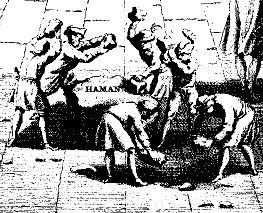 |
Synagogue. Amsterdam, 1731. |
When the Megillah is read it is the custom to make a loud noise so that ![]() 's name can not be heard. The children always pay special attention to the reading and each time that
's name can not be heard. The children always pay special attention to the reading and each time that ![]() is mentioned they shake their greggers (rattles) or stamp their feet. The custom of carving
is mentioned they shake their greggers (rattles) or stamp their feet. The custom of carving ![]() 's name in stone shown in the picture on the right goes back at least to 1567, when Moses Isserles describes it as an Ashklenazi custom,14. but he does not mention the making of noise to drown out the pronunciation of the name. That is mentioned by Ganzfried in 1864.15. In the picture (below left) a young boy appears to be hammering on a piece of wood. It is not clear whether he is destroy the name written on it or making a loud noise to drown out the sound. Various devices are now used for noise making, but many congregants just boo. It also used to be the custom to write
's name in stone shown in the picture on the right goes back at least to 1567, when Moses Isserles describes it as an Ashklenazi custom,14. but he does not mention the making of noise to drown out the pronunciation of the name. That is mentioned by Ganzfried in 1864.15. In the picture (below left) a young boy appears to be hammering on a piece of wood. It is not clear whether he is destroy the name written on it or making a loud noise to drown out the sound. Various devices are now used for noise making, but many congregants just boo. It also used to be the custom to write ![]() 's name on the soles of ones shoes in chalk. By stamping ones feet the chalk name gradually disappeared.
's name on the soles of ones shoes in chalk. By stamping ones feet the chalk name gradually disappeared.
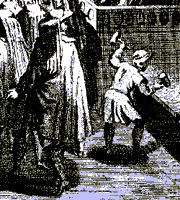 |
by hammering. Amsterdam, 1731. |
The reason for the custom is based upon the verse And you shall blot out the name of Amalek from under heaven.16. ![]() was an Agagite,17. who was therefore a descendent of Agag. Agag was king of Amalek.18. This plainly shows that
was an Agagite,17. who was therefore a descendent of Agag. Agag was king of Amalek.18. This plainly shows that ![]() was an Amalekite.
was an Amalekite.
It is however the custom may well predates Purim and the book of Esther. Schauss maintains 19. that the old spring festival marked a change of seasons, and at that time the people thought themselves vulnerable to the influence of evil spirits. They therefore made a lot of noise to drive off any evil spirits that might be near. It is doubtful whether the custom goes back that far as both the Mishnah and the Talmud mention the reading of the Megillah but neither mention the custom of blotting out the name. It seems probable that the custom was introduced during the persecutions of the ghetto period, when the Jews vented their pent-up feelings against their current persecutors by blotting out the arch enemy ![]() .
.
(14.) S.A. Orach Chayim 690, #17. (15.) K.S.A. vol 3, 141, # 13. (16.) Deut. 25, 19. (17.) Esther 3, 1. (18.) 1 Sam. 15, 8. (19.) Jewish Festivals, pp. 265-6
The book of Esther described how although the Jews attacked their enemies on the 14th of the month, those Jews living in the capital of Shushan were allowed to continue to defend themselves on the 15th.20. It therefore became the custom that in walled cities dating back to the time of Joshua they would observe Purim on the 15th of Adar, while in other places it would be observed on the 24th.21. To this day Jerusalem observes it a day later than other places. It was also the custom that in small villages they would have the reading of the Megillah when they went into the synagogues in the nearest town. This was on the Mondays or Thursdays when they went to Synagogue before going to the market.
(20.) Esther 9, 18 (21.) Meg. 1, 1.
The food most associated with Purim is ![]() tashen. These are triangular pastries usually filled with poppy seeds. Poppy seeds are used because they are bitter,22. reminding us of
tashen. These are triangular pastries usually filled with poppy seeds. Poppy seeds are used because they are bitter,22. reminding us of ![]() 's bitter hatred of the Jews. Various explanations have been given for the name:
's bitter hatred of the Jews. Various explanations have been given for the name:
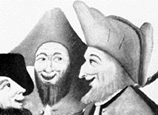
(22.) The Shalom Bagel Bakery, Gants Hill. (23.) Encyclopoedia Judaica vol 13, col. 1392.

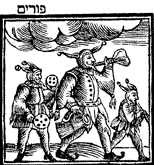 |
of drink, Amsterdam, 1707. |
Purim is a particularly joyful occasion and revelry is sometimes carried to excess. Some authorities 24.even recommended that we should drink until we can not tell the difference between "Cursed be ![]() " and "Blessed be Mordecai". The excuse for this drinking is that the whole story of Esther really began with the banquet where King Ahasuerus and his courtiers were "merry with wine". 25. For that was the occasion when Queen Vashti refused to appear before the drunken King, and was disgraced , paving the way for Esther to marry the King. However other sources add that if such drunkenness should cause one to fail to observe some duty or cause him to make mistakes in reading his prayers, then it would be best if one did not drink to excess.26.
" and "Blessed be Mordecai". The excuse for this drinking is that the whole story of Esther really began with the banquet where King Ahasuerus and his courtiers were "merry with wine". 25. For that was the occasion when Queen Vashti refused to appear before the drunken King, and was disgraced , paving the way for Esther to marry the King. However other sources add that if such drunkenness should cause one to fail to observe some duty or cause him to make mistakes in reading his prayers, then it would be best if one did not drink to excess.26.
In Tel Aviv there is an annual Purim carnival which is called Ad Lo Yada which means "Until one does not know" (the difference).
(24.) Meg. 7b. and S.A. Orach Chayim 695, 2. (25.) Esther 1, 10. (26.) Ganzfried K.S.A. 3, 142, #6.
Because Purim celebrates the saving from danger, some communities and some families observed a Purim on the anniversary of the day when they were saved. So Prague Jews celebrated a special Purim 14th Cheshvan because in 1620 Ferdinand II protected them from rioting mobs. While the Brandeis family from Bohemia celebrated "Plum Jam Purim" on 10th Adar because in 1731 David Brandeis was saved from the accusation that he had killed gentiles with poisoned plum jam.27.
(27.) E.J. vol 13, pp 1397-9.
 |
Utrecht, 1657. |
The book of Esther describes Purim as a day of gladness and feasting, and a holiday, and of sending portions one to another.28. These gifts which were usually food, were made to gentiles as well as to Jews. 29. The presents were sometimes spoken of as "shelachmones".
(28.) Esther 9, 19. (29.) S.A. Orach Chayim 694,3.
Before Esther went in to speak to King Ahasuerus, she asked Mordecai to declare a three day fast.30. The date of these fasts was not mentioned in the Bible, but according to the story was clearly quite some time before 14th Adar. Rabbinic tradition said that the dates were in Nisan. By the 8th century CE Rabbi Acha of Shabcha mentions this as a one day fast occurring on 13th of Adar. By that date NICANOR'S DAY had been completely lost. This Fast was less strictly observed than those fasts mentioned in the Bible.
(30.) Esther 4, 16.

Purim has remained a minor festival. There is a Yiddish saying that just as a high temperature is not necessarily the sign of a serious illness so Purim is not a festival. Some Reform congregations did not observe Purim. The reasons they gave were:
NOTES ON THESE REASONS..
1. Today almost all Liberal and Reform synagogues keep Purim. The Holocaust taught us that the threat of persecution may come when it is least expected. Though some still feel that it would be better if Purim was observed by the non-Jews.
3. The reformers were not the only ones to try to improve decorum at Purim. In 1783 the elders of Bevis Marks Synagogue decided to ban the practice of knocking on the benches whenever the name of You-Know-Who was mentioned. At the evening service of Purim there was a revolt by several members, and the next day they obtained the assistance of two constables to help them keep order.31.
4. Although there is no direct mention of God in the megillah, some see the reference to the passage which told how, when Esther hesitated to intercede for the Jews, Mordecai said: If you keep silent at a time like this, help will come to the Jews from another place.32. The word used for place is Makom. Several centuries later, Makom was regarded as one of the names for God. R. Ammi said The Lord is the place of His world, His world is not His place.33. This meant that the world is contained in Him, He is not contained by the world. (ie. God is infinite, but the world is finite.)
(31.) Picciotto: Sketches of Anglo-Jewish History, p. 195f. (32.) Esther, 4, 14. (33.) Gen. Rabba, 58, 9.
| FOR FULL ALPHABETICAL INDEX |